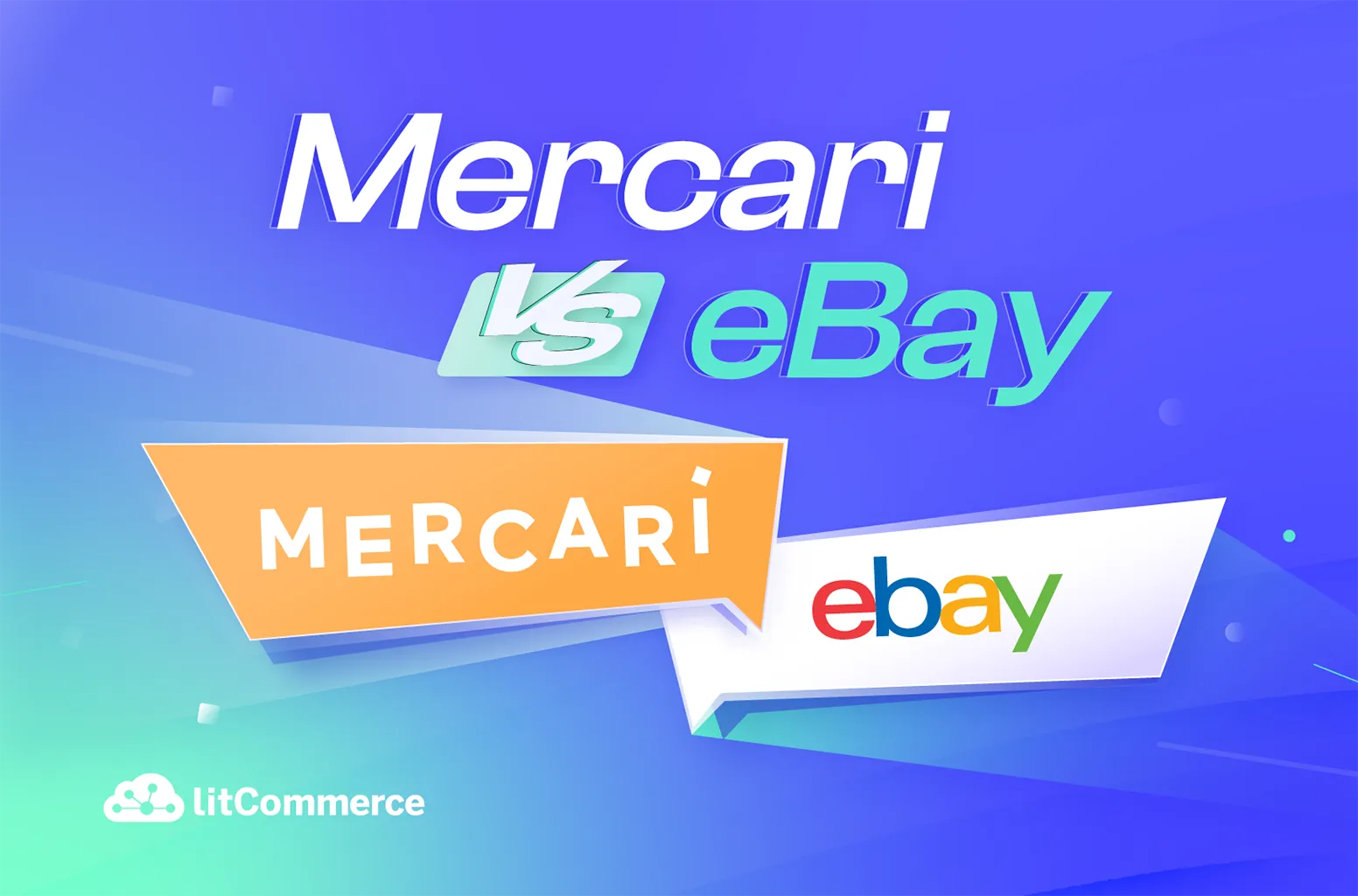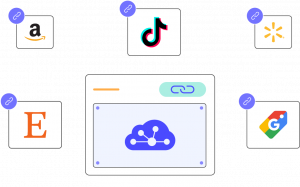Mercari vs eBay, which is better for eCommerce sellers? This is a tricky question. Both Mercari and eBay have built solid reputations as go-to online marketplaces.
Mercari is known for its simplicity and user-friendly experience, perfect for those looking to sell quickly and without too much hassle. On the other hand, eBay, with its massive global audience and range of selling options, offers a more comprehensive, but sometimes more complex experience.
Continue reading and exploring more to learn which is a better choice for you in 2025, Mercari or eBay.
Ever Thought of Multichannel Selling?
Grab your business scaling opportunity by going multi-channels with LitCommerce. Inventory, prices, and orders will be synced in real-time, all in one dashboard.
This comparison is brought to you by LitCommerce — a well-known multichannel selling tool with powerful eBay integration. The insights in this article are based on real data and feedback gathered from thousands of eBay sellers using LitCommerce to manage their multichannel operations.
Mercari vs eBay: Platform Overview
What is Mercari? What to know about this platform?
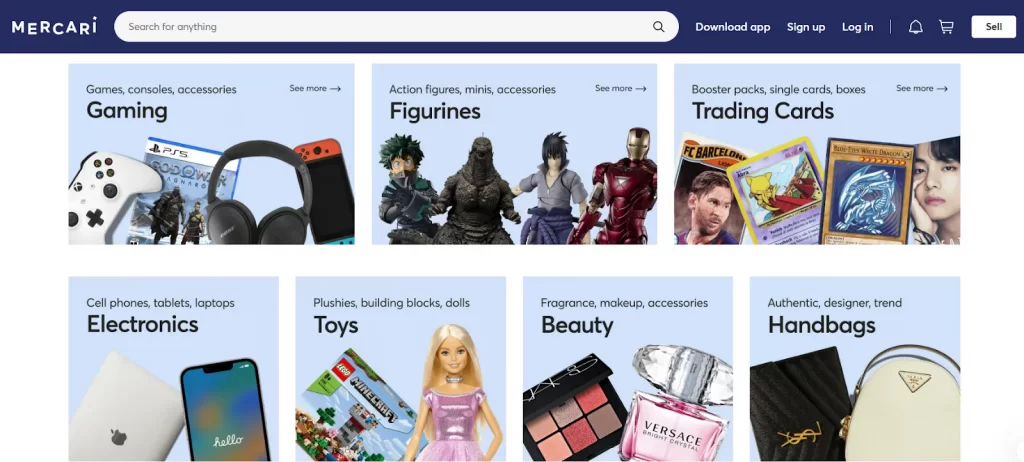
If you want a simple, mobile-friendly way to sell online without setting up a full store, Mercari might be your answer. This mobile-first, peer-to-peer marketplace—born in Tokyo in 2013 and launched in the U.S. in 2014—lets you list almost anything, from vintage sneakers to gaming consoles, with just a few taps. It’s designed for ease: you don’t need a storefront, the app guides you through listings, and nationwide shipping opens your items to buyers everywhere.
Key 2025 stats sellers should know
- 50M+ U.S. downloads and 22.7M monthly active users mean plenty of eyes on your products. (thredUP’s 2024 Resale report)
- A 4% growth in GMV in FY2025 indicates that the platform is holding its ground despite stiff competition. (Morningstar’s report in June 2025)
- 10% flat seller fee keeps costs predictable—no complicated tiered pricing.
- AI seller tools cut listing time by 30% and boost sales conversions by 20%.
- Top-selling categories include gaming gear, sustainable fashion, home goods, electronics, and collectibles.
Pros of selling on Mercari
✅ Low barrier to entry – Great for casual declutterers or part-time resellers.
✅ Younger, trend-driven audience – Ideal for products like streetwear, gaming, or pop culture collectibles.
✅ Nationwide reach – Every listing can be viewed by buyers across the U.S.
✅ Secure transactions – Payments are held until the buyer confirms satisfaction.
✅ No upfront listing fees – You only pay when you sell.
Cons to consider
❌ Highly competitive in popular categories – Standing out can require frequent price adjustments.
❌ Buyer expectations for deals – Some shoppers expect thrift-store-level pricing.
❌ Limited customization – You can’t build a branded storefront like eBay.
❌ Occasional slow sales – Niche or high-priced items may take longer to move.
❌ Younger demographic focus – Not always ideal for antiques or non-trendy categories.
Mercari is a strong choice if you sell trending, in-demand products and want a low-hassle way to reach millions of buyers nationwide. Its AI tools, predictable fees, and mobile-first design make it especially appealing for sellers who value speed and simplicity.
What is eBay? What should sellers notice in 2025?

For almost three decades, eBay has been one of the most recognized names in online selling. Founded in 1995, the platform connects millions of buyers and sellers worldwide for everything from everyday bargains to rare collectibles. Unlike many marketplaces, eBay offers two main selling formats—auctions and fixed-price “Buy It Now” listings—giving you more control over how you market your items. With international reach through the Global Shipping Program, you can sell to buyers far beyond your own borders.
Key 2025 stats sellers should know according to Yaguara’s report, May 2025:
- With 134M active buyers worldwide, and roughly 70% in the U.S., your listings enjoy unmatched visibility.
- 18.3M sellers globally—most of them small businesses—keep the marketplace diverse and active.
- 2.1B active listings offer variety, but also mean competition is intense.
- $19.5B GMV in Q2 2025, with U.S. GMV up 7% year-over-year.
- 10–15% seller fee (final value + listing fees) impacts margins but comes with a massive audience reach.
- Strong categories include collectibles, vintage, motors, trading cards, and hard-to-find parts.
Pros for selling on eBay
✅ Global audience – Reach buyers in over 190 countries with built-in shipping solutions.
✅ Flexible selling options – Choose auctions for competitive bidding or fixed-price for steady sales.
✅ Strong niche markets – Perfect for collectibles, vintage goods, and specialty items.
✅ Seller support tools – Analytics, advertising options, and protections to help grow your sales.
✅ Established trust – eBay’s long-standing reputation attracts serious buyers and collectors.
Cons to consider
❌ High competition – Popular categories can trigger pricing battles and lower profits.
❌ Fee structure – Multiple fees can add up quickly, especially on lower-margin goods.
❌ Algorithm dependence – Your sales can fluctuate with changes to search rankings.
❌ Shipping complexity – Especially for international orders, managing logistics can be time-consuming.
❌ Buyer-leaning dispute policies – Resolutions often favor customers in conflicts.
eBay offers sellers one of the largest, most diverse buyer pools in the world, especially valuable for niche, collectible, and vintage markets. However, to succeed in 2025, you’ll need to manage fees, stay competitive in pricing, and make full use of eBay’s selling tools to stand out.
Also read: Etsy vs eBay: Where to Start Making Money
Mercari vs eBay: A Detailed Comparison
Now that we’ve briefly gone over Mercari vs eBay for sellers, let’s compare these two platforms to help you determine which one is best for your business.
1. Selling fees
When looking at Mercari vs eBay fees, you’ll find that the selling fees they offer differ significantly.
Mercari fees
When it comes to costs, Mercari keeps things refreshingly simple. As of January 6, 2025, the platform charges a flat 10% selling fee on the combined total of your item price plus any buyer-paid shipping. That means no surprise percentages, no sliding scales—just one predictable rate.
Example: Sell an item for $50 and the buyer covers $10 shipping, and the 10% fee applies to $60. Your total selling fee would be $6.
Here’s what makes Mercari’s fee structure appealing for many sellers:
- No listing fees – You can post as many items as you like without paying upfront.
- No separate payment processing fees – The 10% already covers it.
- Free ACH withdrawals – Only failed transfers incur a $2 fee.
- Optional instant payouts – Get your money faster for $3 per transaction.
- Extra services are optional – Fees for things like luxury authentication don’t apply to most sales.
For sellers, this means you can easily predict your profit before listing—making Mercari’s fee model one of the more transparent and competitive in the peer-to-peer resale space.
Fee type | Details |
Listing fees | $0 to list items. Mercari does not charge for creating listings, making it simple to post your items for sale. |
Selling fee | Flat 10% selling fee on item price + buyer-paid shipping for all sales starting January 6, 2025, with no payment processing fee. |
Payment processing fee | No separate payment processing fee. |
Balance withdrawal fees | Free ACH withdrawals; $2 fee only for failed transactions; $3 for Instant Pay |
Shipping and delivery fees | Shipping rates are based on package size and weight, offering up to 39% savings compared to retail prices USPS, FedEx, and UPS. For packages under 50 lbs and 34” in size, rates automatically. |
Over shipping fees | If the package exceeds weight or size limits, sellers are responsible for overage fees or fines associated with improper shipping methods. |
Local delivery fees | $15.99 for items smaller than a microwave (22”H x 30”W x 25”D) under 50 lbs. Larger items or furniture delivery in select cities costs $199 for up to 3 items. |
Cancellation fees | A 5% cancellation fee (up to $25) may apply if the seller frequently cancels orders. This covers transaction fees and operational costs. |
Other service fees | $25 per hour for subpoena processing in case of legal requests. |
Additional service fees may apply for extra services offered by or through Mercari, as communicated at the time of the service. |
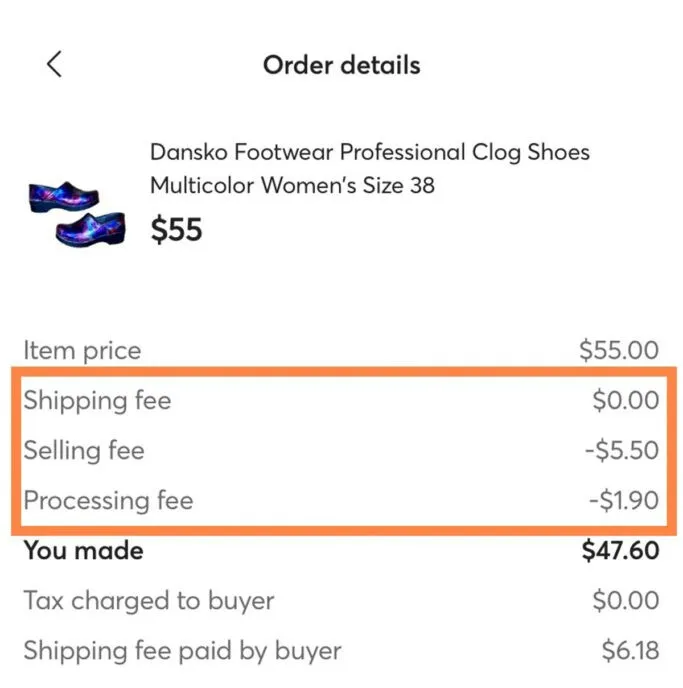
eBay fees
eBay’s fee structure is more complex than Mercari’s flat rate, but it offers flexibility for different selling volumes and categories. In 2025, sellers face a mix of listing costs, percentage-based sales fees, and optional upgrades, with opportunities for discounts if you meet performance standards.
Key fee components:
- Insertion fees (listing fees): You get 250 free listings per month without a store subscription. After that, it’s $0.35 per extra listing. Store plans include more free listings—Premium plans allow up to 1,000 before insertion fees kick in at a slightly lower rate.
- Final value fees: Most categories are 13.25% of the total sale amount (item price + shipping + tax), plus a $0.30 fixed fee per order. Rates vary—books can be 14.6%, handbags up to 15%, while some electronics are lower. For sales above certain thresholds (e.g., $7,500), the percentage drops to 2.35% for the portion above that cap.
- No separate payment processing fee: eBay’s Managed Payments system bundles processing into the final value fee.
- Performance-based adjustments: A “Below Standard” rating adds 6%, and high return rates can add 5% on affected sales. Top-rated sellers can earn up to 10% off.
- Extra charges for international sales (1.7% for U.S. sellers) and optional features like promoted listings or premium upgrades.
Example: If you sell an item for $100 and the buyer pays $10 for shipping, the total sale amount is $110. In a category with a 13.25% final value fee, your selling fee would be $14.58. Adding the $0.30 fixed per-order fee brings your total eBay fee to $14.88.
For sellers, eBay’s model rewards high performance and smart category selection, but it also means you need to track your costs closely, especially if you list in bulk or sell in competitive categories.
Fee type | Details |
Insertion fees | $0.35 per listing after your first 250 free listings each month. If you list more than 250 items, you’ll start paying this fee for each additional listing. |
Final value fees | From 13.25% to 15% of the total sale price, including shipping. This percentage can vary depending on the product category and location. |
Additional final value fees | An extra 5-6% fee is applied if your account doesn’t meet eBay’s seller performance standards. |
Real estate listing fee | $35 to $300 per listing for properties in the Real Estate category, which is a flat fee regardless of whether the property sells. |
Promoted listing fee | A fee you choose, usually a percentage, to boost your item’s visibility. You only pay if the item sells through the promoted listing. |
Dispute fee | $20 is charged if a buyer successfully files a claim against you and it’s decided in their favor, such as in cases of refunds or disputes. |
International selling fees | A 1.7% fee applies when selling to buyers outside your registered country, in addition to the final value fee. |
Store subscription fees | eBay offers store subscriptions ranging from $4.95 to $299.95 per month, depending on the plan you choose, with benefits like reduced fees and promotional tools. |
Seller currency conversion fees | If you sell in a currency other than your registered one, eBay charges a 3% conversion fee on the total amount received. |
Key takeaway: Mercari selling fees, with its free listings, no selling fees for new listings and a simpler fee structure, are generally lower and more affordable for casual sellers. Whereas, eBay provides more tools but comes with higher fees.
2. Listing process
Looking at Mercari vs eBay, the next thing to consider is listing process. When you try to sell your products on different marketplaces, the listing process can significantly impact your overall experience.
Mercari listing process
Creating a listing on Mercari is quick and easy with a simple 3-step guide:
- Upload product images: Mercari allows up to 12 photos per listing.
- Write a product description: Mercari requires sellers to include details like the item’s condition, color, size, and any flaws it may have. For certain products, this platform may auto-fill some details, but sellers can always edit them before posting.
- Price it right: Mercari provides Smart Pricing, where you set a start price and a floor price, and this platform will gradually adjust it based on demand. You can also enable Smart Offers to automatically accept or counter offers within a price range they set.
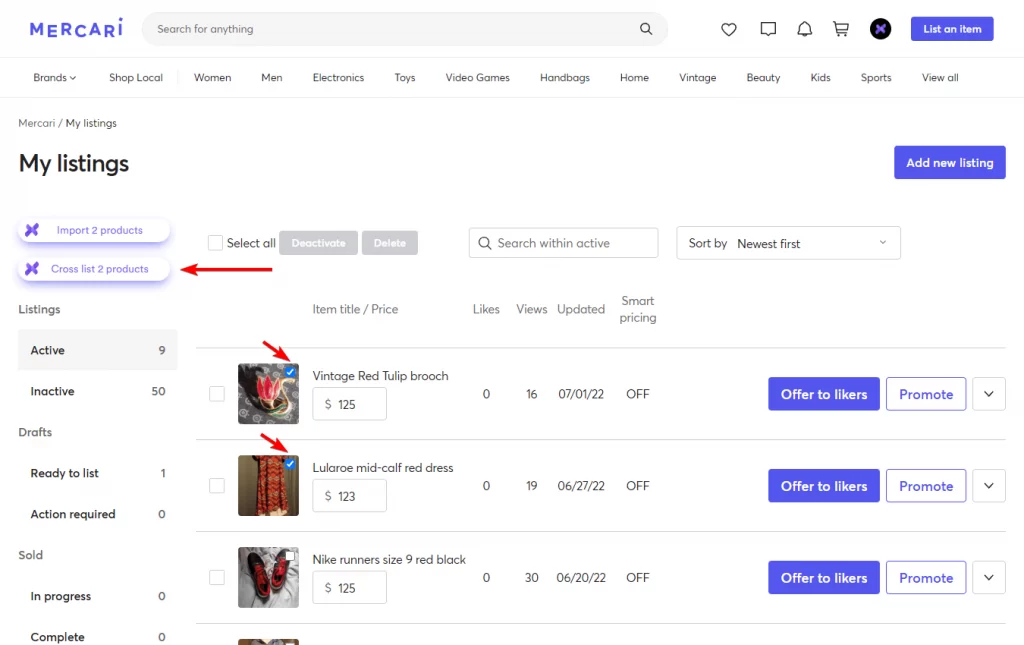
eBay listing process
eBay currently supports 2 listing types:
- Auction: During the listing period, you receive bids for the item. At the end of the listing, the highest bidder who also meets the specified Item Reserve Price (if applicable) wins the item. Also, sellers can choose to enable a Buy It Now option for the item, allowing buyers to purchase it at the Item.BuyItNowPrice.
- Fixed-price: When sellers list an item at a fixed price, buyers can purchase it immediately without having to bid. Sellers can also activate the Best Offer feature on a fixed-price listing, which allows buyers to suggest a lower price to sellers for consideration.
Below is the typical listing process on eBay:
- Upload photos and videos: eBay allows multiple photos and even videos for certain listings, helping you showcase your item in greater detail. High-quality visuals are key to standing out.
- Product description: You’re required to write a detailed description, covering the condition, brand, size, and other important details. eBay also provides categories and product templates, which can speed up the process for certain items.
- Set price and auction options: One of eBay’s strengths is its variety of pricing models. You can list items with a fixed price or go the auction route, allowing buyers to bid on your item. eBay also has tools like Promoted Listings to boost visibility and international shipping options to reach a wider audience.
Compared to Mercari, eBay’s process offers more flexibility and customization, which can be a plus for sellers with diverse inventory or those looking for advanced selling options. One of the key features is the multi-quantity listings and variations option, allowing sellers to list multiple items of the same product under a single listing.

Key takeaway: While eBay’s listing process takes a bit more time compared to Mercari, it gives you more control over how your items are presented and sold.
Built for eBay Sellers Who Want to Grow
eBay offers massive potential — and LitCommerce eBay Integration helps you make the most of it. With features custom-built for eBay sellers, you can easily sync listings, track inventory, and manage all orders from one powerful dashboard.
3. Shipping options & cost
Shipping goes beyond mere operational details, it plays a crucial role in customer satisfaction and is vital for the success of any business. Hence, when comparing Mercari vs eBay, you need to consider their shipping options & cost.
Mercari shipping options & cost
For shipping on Mercari, you have three options:
- Mercari prepaid labels: This is the easiest and most recommended option, especially for new sellers. With flat-rate pricing through USPS and FedEx, it simplifies the shipping process. Plus, if you follow Mercari’s Shipping Protection guidelines, your package is covered up to $200 for most rates, and up to $20 for First-Class Envelope rates. However, the prepaid label rates can be two to three times more expensive compared to using services like Pirate Ship.
- Mercari local: This option is ideal for larger, bulky, or fragile items that need professional packing. It’s a hassle-free service, but only available if the seller covers the shipping cost. While you can purchase insurance for added protection during transit, this service is limited and comes with extra costs.
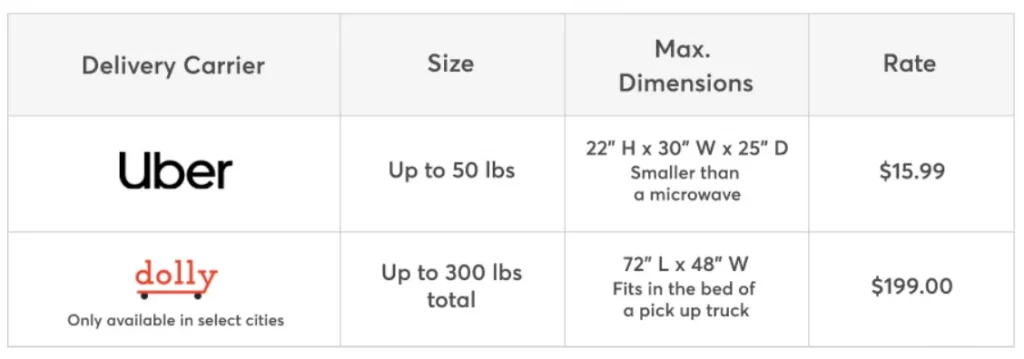
- Ship on your own: This option gives you the most flexibility and cost savings, as you can choose any shipping carrier and service that suits your needs, and often find cheaper rates than Mercari prepaid labels. But it requires more effort, and you won’t have Mercari’s protection for lost or damaged packages.
From July 10, 2024, Mercari allows consumers to purchase items shipped from international sellers, specifically from Japan. Notably, items listed for international shipping are sourced by BEENOS, Inc., and can be identified by specific badges on the item detail and checkout pages. And delivery times for these items typically range from 6 to 14 days. Also, some features like offers and bundle deals are not available for internationally shipped items.
eBay shipping options & cost
Unlike Mercari, eBay offers sellers the ability to ship to over 100 countries, extending beyond just domestic shipping. But it’s important to plan ahead to secure the most affordable shipping rates. You have a couple of shipping options to choose from:
- Flat rate shipping: Many sellers opt for flat rate shipping, which allows them to charge a standard fee regardless of the package weight or destination within specified limits. Also, this shipping option is particularly appealing for buyers, as they know exactly what to expect in terms of shipping costs.
- Calculated shipping: Calculated shipping lets you set shipping charges based on the buyer’s location and the package’s weight and dimensions. While this can lead to varying costs for different buyers, calculated shipping ensures that you cover your shipping expenses accurately (particularly beneficial for larger or heavier items.)
Also, you can decide to offer free shipping to draw in more buyers. Although you need to account for these costs in the item’s price, this strategy often boosts sales and enhances customer satisfaction.
If you’re selling internationally, eBay’s International Shipping Program simplifies the process. You can simply send your item to eBay’s global shipping center, and they take care of everything from customs paperwork to delivery in the buyer’s country. But you need to note that international shipping fees can be higher for buyers, which may not appeal to everyone.
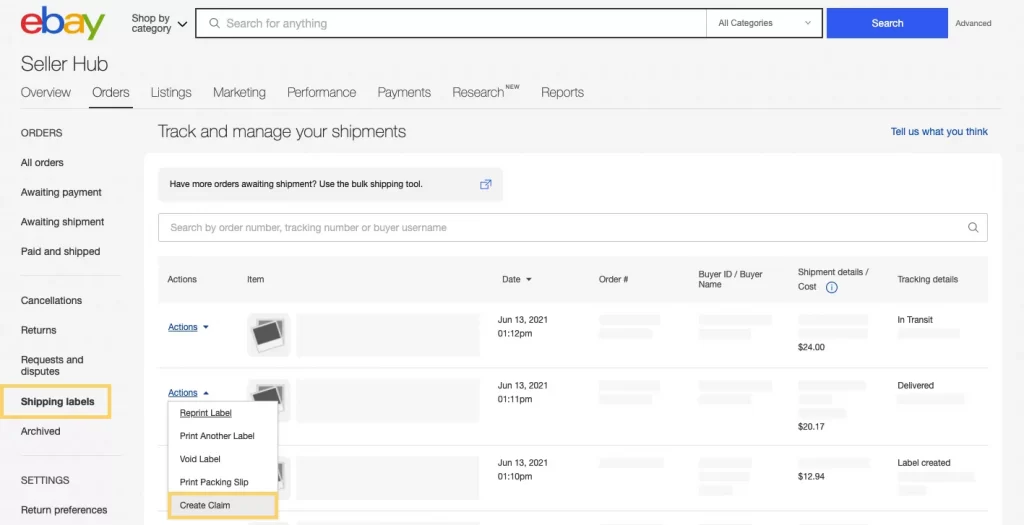
Recommendation: When comparing Mercari vs eBay, while both platforms have their strengths, eBay’s International Shipping Program provides a significant advantage for sellers looking to expand their reach and increase their sales opportunities on a global scale.
4. Extra features
Seller tools are vital for optimizing your performance and staying competitive in the marketplace. Let’s explore some extra features that Mercari and eBay offer to sellers.
Mercari extra features
- Smart pricing: Mercari’s smart pricing feature enables you to set a “starting price” and a “bottom line” price. It continuously adjusts the listing price until it reaches the minimum, promoting your item to potential buyers with each update.
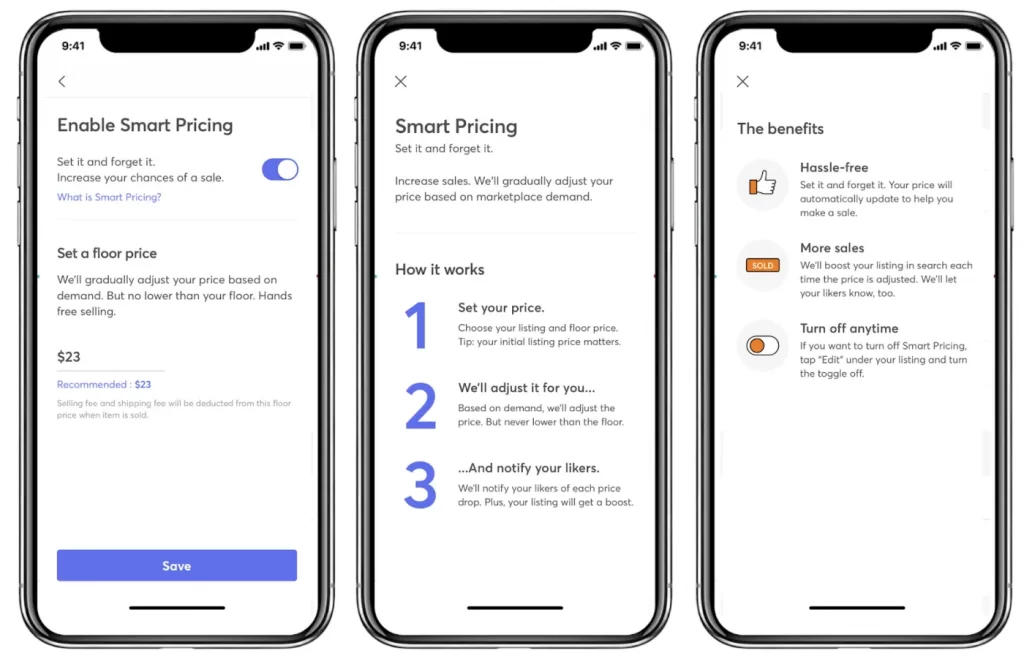
- Smart offers: When creating or editing a listing, you can enable smart offers. This feature saves you time by allowing you to establish a minimum price for your listing and automatically generate a one-time counteroffer within your acceptable price range. If an incoming offer falls within this range, it will be accepted. If it’s outside the range, a counteroffer will be sent automatically for negotiation with the buyer.
- Vacation mode: Vacation mode allows you to take a break from selling or travel without worrying about new orders. Your listings will be hidden for the duration you specify, preventing purchases during that time. However, the algorithm of Mercari tends to favor active listings that consistently receive views, sales, and engagement. Hence, when your listings are inactive for an extended period, they may lose their ranking position
eBay extra features
With the lofty expectations that come from being one of the largest marketplaces in the world, eBay offers a wide array of features designed to support sellers in achieving success:
- Private listings: When creating a listing, sellers have the option to mark it as private. This option conceals the user IDs of bidders from anyone viewing the active listing, except for the sellers themselves, ensuring anonymity for the bidders.
- Active listings: Active listings feature allows sellers to view and manage all their current listings in one place, including tracking the performance of listings, making updates, and responding to buyer inquiries efficiently. Thanks to this, you can maintain organization and ensure they are on top of their sales activities.
- Immediate payments: You can choose to require immediate payment for: a fixed-price listing, an auction-style listing with the Buy It Now option enabled, and a deposit on a motor vehicle. If you want to require immediate payment, several conditions apply, you can read more in eBay development program.
- Promotions manager: Promotions manager is a powerful marketing tool available to sellers with an eBay store subscription. It enables sellers to create and manage various promotional offers directly on their storefronts. Some of the promotional options include order discounts, coupons, shipping discounts, sale events, and volume pricing discounts.
- Selling templates: This feature allows sellers to create reusable listing templates, streamlining the listing process. Sellers can design templates that include all necessary information, which can be easily revised, renamed, or deleted as needed.
Recommendation: When choosing between Mercari and eBay, consider your selling style and needs. Both platforms offer valuable tools but they cater to different seller requirements. eBay tends to have the edge, as it provides more advanced features for sellers.
5. Getting paid
As a seller, you absolutely want to know how a platform pays you after a successful order. Let’s see how eBay vs Mercari handles their payment processes to understand which might work best for you.
Getting paid on Mercari
Getting paid on Mercari is straightforward. After completing a sale, your balance becomes accessible once the buyer receives and rates the transaction, or after 72 hours – whichever occurs first.
You can use your balance to shop on Mercari or transfer the funds to your bank account. There are two methods for transferring your balance:
- Instant pay: Instant pay is the quickest way to access your funds when you need extra cash. You can use this option once per day, with a limit of $600 per month on eligible debit cards. The fee for this service is $3, and depending on your bank’s processing time, it may take up to 30 minutes for your bank account to reflect the updated balance.
- Direct deposit: Transfers to your bank account are typically processed the next business day; however, it may take up to 5 business days for the funds to be fully transferred and available in your account. The fee for this service is $2.
Getting paid on eBay
Getting paid for your sales on eBay is also simple. Buyers can choose from various payment methods, and your payouts go directly to your checking account or a Visa/Mastercard debit card. You can track all your payouts in the Payments tab in Seller Hub or My eBay.
If you have daily payouts, it takes about 2 days after confirming a buyer’s payment to initiate the payout. For weekly payouts, eBay processes payments every Tuesday for sales made from the previous Monday to Sunday. Biweekly payouts are initiated every second Tuesday, and monthly payouts happen on the first Tuesday of each month. Your bank will typically make the funds available to you within 1-3 business days.
If you’re on a weekly, biweekly, or monthly schedule, you can request your available funds anytime with the “withdraw” selection within the Payments tab.
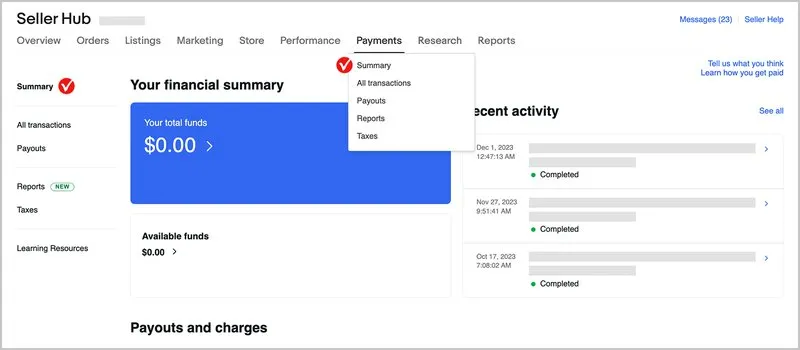
Key takeaway: Considering payment on Mercari vs eBay, both marketplaces have effectively secured their payment methods to ensure a safe transaction experience for sellers. While Mercari focuses on quick access to funds with a simpler process, eBay provides a more flexible and organized approach to managing payments
6. Returns & refunds
We can’t address the Mercari vs eBay issue without talking about returns & refunds policy. Both Mercari and eBay have established systems to handle returns and ensure a fair experience for both buyers and sellers, but they do so in different ways.
Mercari returns & refunds
Mercari’s return policy aims to balance the needs of both buyers and sellers. Buyers can request a return if their item significantly differs from the listing, but they must seek any additional information from sellers before purchasing.
To initiate a return, buyers must do so within 72 hours of delivery through the Order Status or Rating pages. Once a buyer has rated the transaction or 72 hours have passed, returns are not allowed.
For items over 50 pounds, sellers must provide their own shipping labels for returns.
Upon receiving a returned item, sellers have 24 hours to inform Mercari if the item is not in the same condition as when it was shipped. Buyers may inspect the item before returning it. Sellers should report any condition changes through the Order Status Page or Help Center, supplying requested information and photos within 24 hours. Mercari will review the case and take appropriate action.
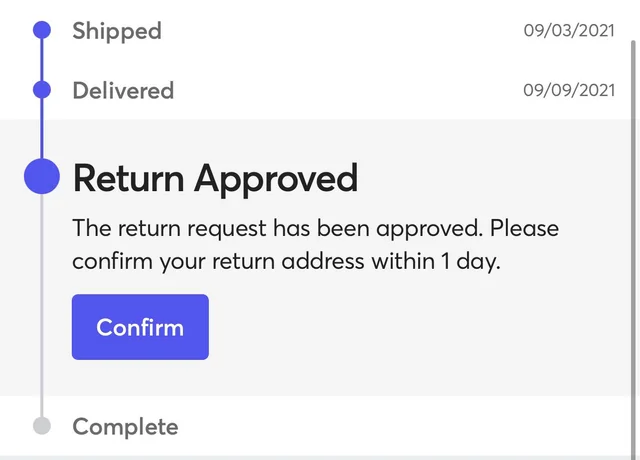
eBay returns & refunds
eBay’s return policy gives sellers plenty of flexibility when it comes to return options, including the choice to accept “No returns.” However, eBay encourages sellers to consider more buyer-friendly options, like a 14, 30, or even 60-day return policy. Plus, offering free returns can really pay off, potentially boosting sales by anywhere from 5% to 25%.
From a buyer’s standpoint, eBay strives to create a smooth and hassle-free shopping experience. By choosing more lenient return options, like the “eBay 30-day return policy,” you might notice a significant increase in your sales.
When buyers request returns, eBay allows sellers to set up rules for quick returns and refunds. Most sellers are quick to issue refunds as soon as they receive the returned item.
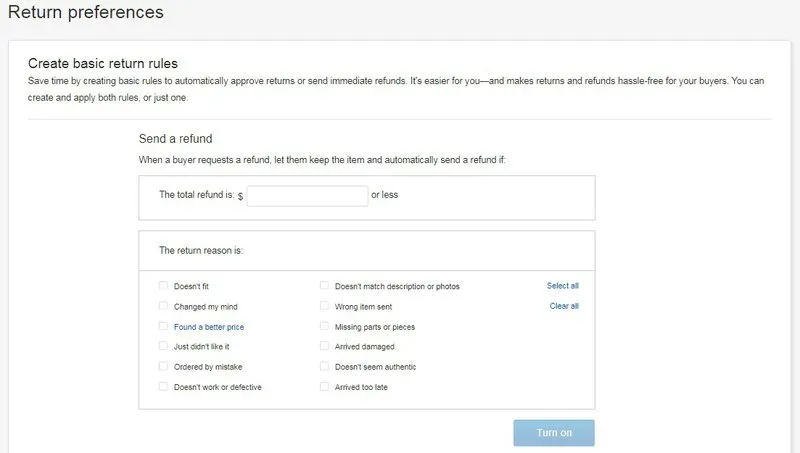
Key takeaway: Comparing Mercari vs eBay, eBay’s return policy is a bit more complicated while Mercari’s focus on transparency helps sellers to communicate their item conditions, which can reduce the likelihood of returns.
7. Seller support
Last but not least, let’s compare the seller support program of Mercari vs eBay, as effective support can greatly influence your experience and success on the platform.
Mercari seller support
Mercari provides a streamlined and simple seller support system designed to be user-friendly. If you have questions or run into issues, the Help Center is your first stop, filled with articles that cover the most common concerns like listing items, handling transactions, and shipping. If you need more assistance, you can reach out through in-app messaging to contact customer support directly.
Mercari also offers a Seller Protection Program, which ensures you’re covered in case of payment disputes or buyer fraud, as long as you follow their guidelines. Plus, their automated system can take care of some tasks for you, such as calculating the best shipping options.
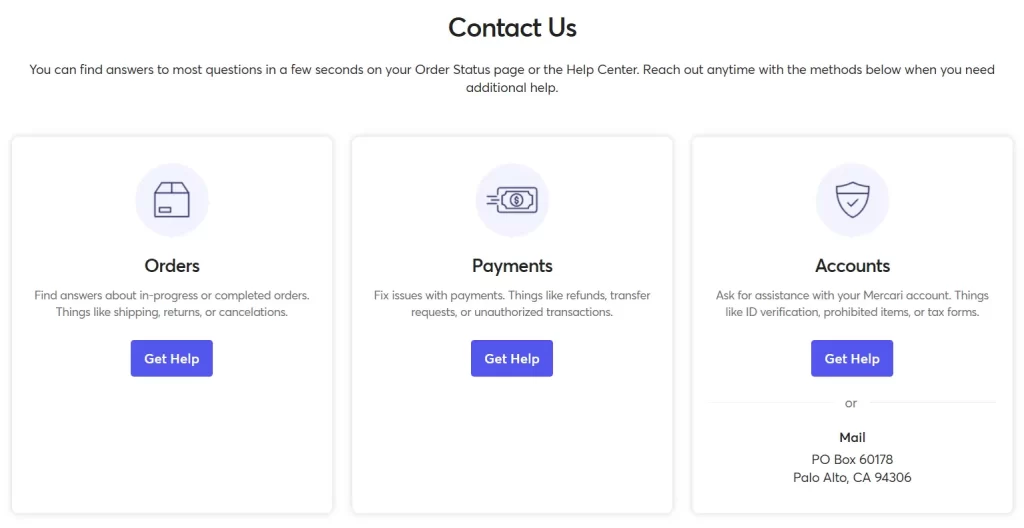
eBay seller support
eBay’s seller support is much more robust, tailored for a range of sellers from casual users to high-volume businesses.
eBay offers a 24/7 customer service team that you can reach via chat, phone, or email. Their Seller Hub is also a great tool, providing access to analytics, performance insights, and a host of resources to help you optimize listings and boost sales.
For sellers looking to expand, eBay provides tools like Promoted Listings and international selling support to help grow your business. Additionally, eBay has a Seller Protection Program that covers fraudulent buyer claims, as long as you meet their guidelines.
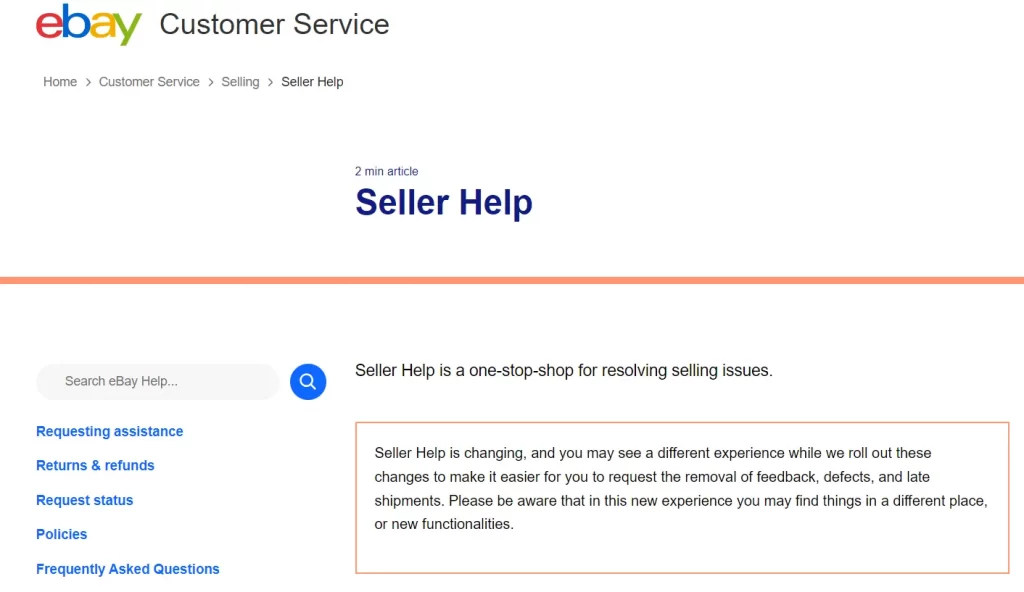
Key takeaway: Both Mercari and eBay provide robust support for sellers. But eBay seems to provide a more extensive support framework that can help sellers navigate the complexities of online selling.
Can You Sell on Both Mercari and eBay?
Yes, you can sell on both Mercari and eBay simultaneously. Many sellers choose to cross-list their items on multiple platforms to maximize their exposure and increase their chances of making sales.
To effectively manage multichannel selling, you should give serious thought to:
- Inventory management: If an item sells on one platform, you need to promptly remove it from the other to avoid overselling.
- Platform policies: Be aware of each platform’s policies regarding selling practices. While it’s generally acceptable to list the same item on multiple sites, ensure you comply with their rules to avoid any issues.
- Time and effort: Managing listings on multiple platforms can be time-consuming, as it involves creating and maintaining separate listings, handling inquiries, and managing shipping.
○ Who should sell on Mercari: Individual sellers looking to sell used, unique, or everyday items with a simple, user-friendly platform.
○ Who should sell on eBay: Businesses and individuals wanting to reach a global audience for new, used, or rare items, especially those seeking auction-style sales.
Selling on Mercari vs eBay – FAQs
Yes, Mercari shipping is generally cheaper than eBay. Mercari offers fixed, prepaid shipping rates that are often more affordable, while eBay allows sellers to set their own shipping rates, which can vary widely. No, Mercari is currently limited to the United States and Japan. In contrast, eBay operates in over 100 countries, making it a more global platform. Many users find Mercari to be more user-friendly, with a simpler listing process. eBay can be more complex due to its extensive features and options.
Mercari vs eBay: Final Thoughts
Is Mercari better than eBay? To conclude, no marketplace is without its pros and cons.
If you’re looking for a straightforward, user-friendly platform with fewer upfront costs, Mercari might be the perfect choice. It’s great for casual sellers or those who want to get started with minimal effort. But if you’re interested in more customization, auction-style listings, or access to a global audience, eBay offers powerful features and reach.
Both Mercari and eBay are excellent starting points for selling your goods, depending on your specific needs.
And if you’re considering expanding your reach and selling on multiple platforms, check out LitCommerce’s multichannel tool. Our platform allows you to integrate multiple marketplaces and eCommerce stores effortlessly. Don’t forget to follow our Retail Blog and join our Facebook community for the latest trends in the eCommerce world. If you have any questions, feel free to contact us anytime!

